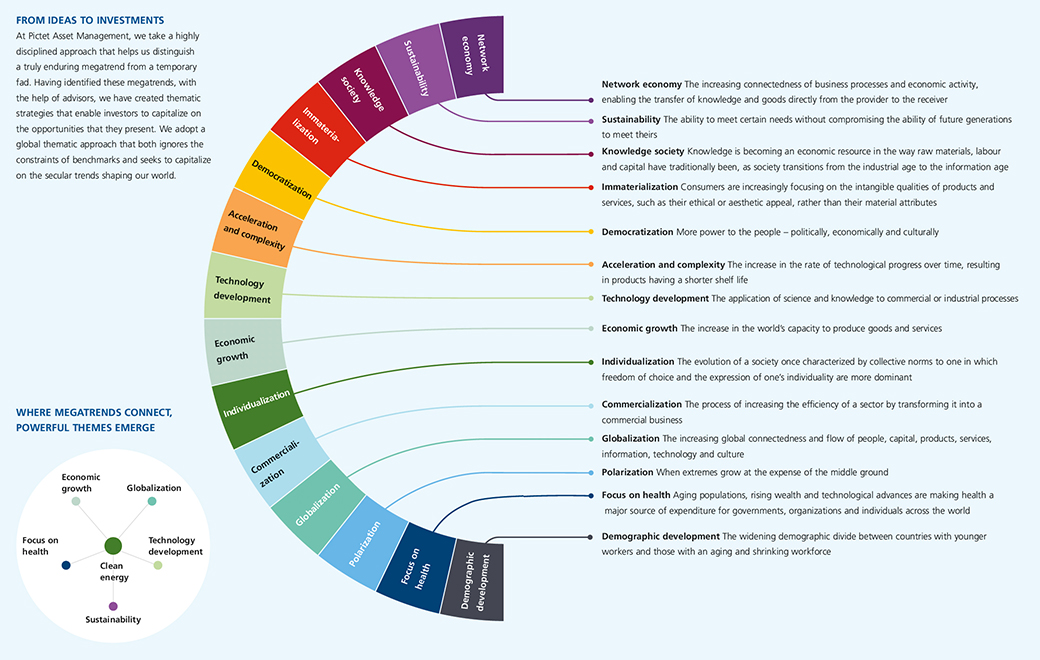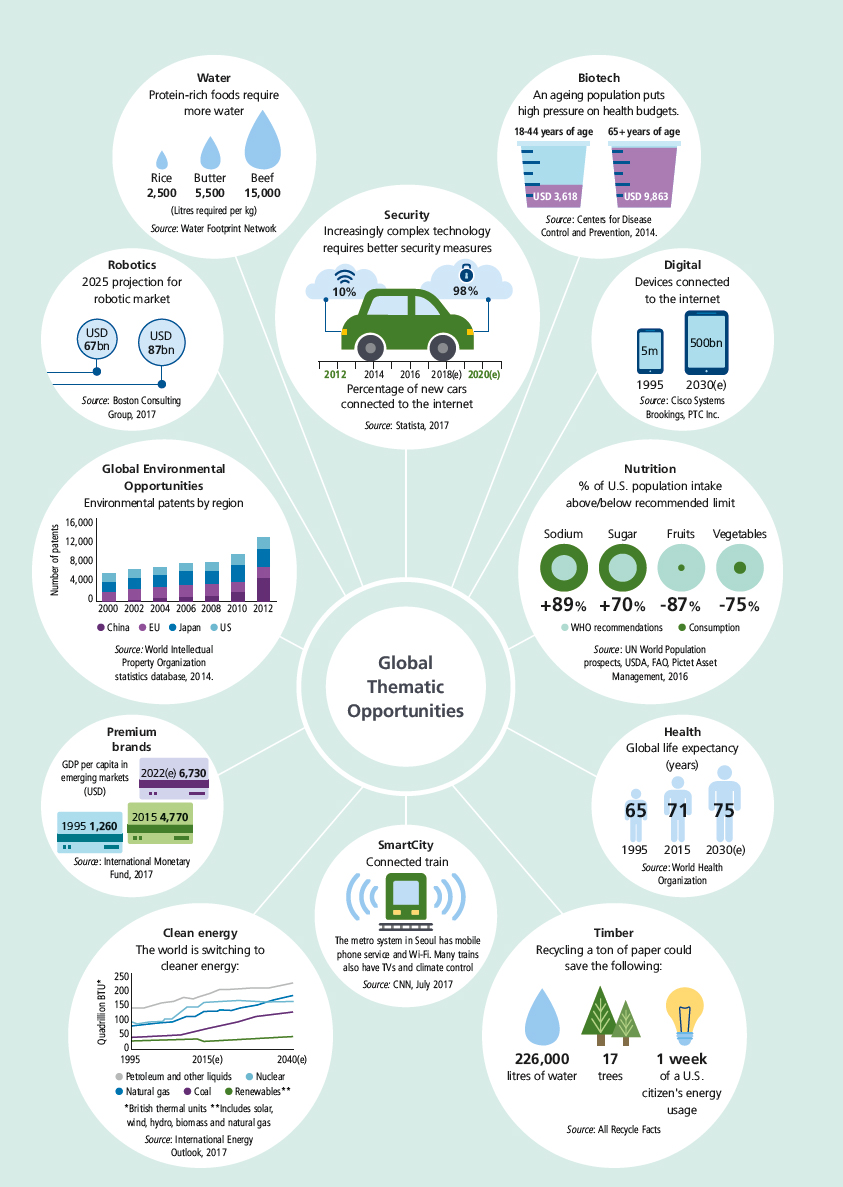Thematic investing – now in Canada

A new way to help build your business with alternative investment solutions.
What sets you apart? For advisors, that’s the million-dollar question, in the sense that answering it in a compelling way can potentially land you the million-dollar account. The trouble is, it’s difficult to stand out when you operate only within the traditional investing environment.
What if you could make meaningful connections with your clients? By offering innovative investment solutions that capitalize on the global trends they read about every day – for example, globalization, democratization, sustainability and a focus on health? Thematic investing, an approach that’s available in Canada through the Manulife Global Thematic Opportunities Fund, aims to identify companies that will succeed in the future by focusing on the structural forces shaping our world, or “megatrends.”
By enabling investors to participate in these megatrends, thematic investing engages them, and thus gives you the opportunity to connect with clients on issues that are important to them. Equally important, because thematic investments are so different from traditional index-based and index-benchmarked investments, adding them to your product shelf can be an effective way to differentiate your advice.
How does thematic investing work?
Traditional investing tends to be backward-looking. It often bases decisions on a company’s past results – despite the fact that that past performance is not necessarily indicative of future returns. Certainly, the companies that make up an index earned their place there based on what they have done, not what they will do.
By contrast, thematic investing is forward-looking. It starts by identifying megatrends – major long-term shifts that are changing the social, economic and investing landscape – and then looks for the individual companies best positioned to benefit from those megatrends over the coming decades.
Thematic opportunities often present themselves as specialized businesses operating in the world’s most dynamic industries. These companies tend to be small to mid-sized today, and they may not have the scale to make it into today’s indexes. But they have the potential to dominate the indexes of tomorrow.
What exactly is a megatrend?
“Megatrends” certainly sound impressive – but what do they look like in practice? Here are some examples that may be incorporated into the analysis of potential holdings in a portfolio of global thematic opportunities:
- Network economy
- Sustainability
- Knowledge society
- Immaterialization
- Democratization
- Acceleration and complexity
- Technology development
- Economic growth
- Individualization
- Commercialization
- Globalization
- Polarization
- Focus on health
- Demographic development
None of these are temporary fads. Each will have an enduring impact on multiple themes. At the same time, each theme is likely to be affected by more than one megatrend. That is, megatrends often intersect to form investable themes – for example, the megatrends of sustainability, focus on health, technology development, economic growth and globalization all have the common theme of clean energy.
From ideas to investments

Thematic investing involves discovering and identifying interactions between megatrends and then finding companies focused on an activity that may benefit from those interactions. In clean energy, that may mean businesses that are constructing and operating smart buildings, developing smart grids, creating solar, wind and hydroelectric renewable energy, or producing low-carbon energy such as natural gas.
By finding companies that share a common mission of creating solutions to some of our biggest challenges, but that operate in different sectors with different specialties, the Manulife Global Thematic Opportunities Fund in particular can provide diversified exposure to the future.
12%...
Just 12 per cent of Fortune 500 firms in 1955 still made the list in 2017 – 60 out of 500¹ – and, in our fast-paced world, the speed of replacement may be ramping up. One study suggests that half of the firms in today’s S&P 500 Index will be off the list within 10 years.² Thematic investing seeks companies with the potential to replace them.
Your business growth opportunity
With the Manulife Global Thematic Opportunities Fund, we’re providing you with a fresh way to get your clients excited about investing.
Gertjan van der Geer, Senior Investment Manager at Pictet Asset Management, sees the Manulife Global Thematic Opportunities Fund fitting into the core equity component of an investor’s portfolio. “It matches very nicely with a passive equity stake,” he explains. “If you have passive, you want to pair it with something that is truly active and not closet indexing, and a fund such as this one truly is active. Its active share is extremely high versus the MSCI World [Index].”
Global Thematic Opportunities

The recommended time horizon for Manulife Global Thematic Opportunities Fund investors is a minimum of five years.
Thematic investing enables investors to put their money into ideas they feel passionate about. In other words, their return on investment can be bigger than simply financial, and they can become invested – in every sense of the word – in the solutions you propose.
That’s good for your clients, because when they embrace an investment approach wholeheartedly, they’ll be more likely to hold on to it through short-term volatility and benefit from long-term returns. It’s also good for your practice, because deeply committed investors can be loyal clients and generous ambassadors who share their positive impressions of you with friends and family and, over time, help you build a more successful business.
Important disclosure
Important disclosure
1 https://www.aei.org/carpe-diem/fortune-500-firms-1955-v-2017-only-12-remain-thanks-to-the-creative-destruction-that-fuels-economic-prosperity/ 2 https://www.innosight.com/wp-content/uploads/2016/08/Corporate-Longevity-2016-Final.pdf
The persons and situations depicted are fictional and their resemblance to anyone living or dead is purely coincidental. This media is for information purposes only and is not intended to provide specific financial, tax, legal, accounting or other advice and should not be relied upon in that regard. Individuals should seek the advice of professionals to ensure that any action taken with respect to this information is appropriate to their specific situation. E & O E. Commissions, trailing commissions, management fees and expenses all may be associated with investments in the Manulife Mutual Funds and Manulife Exchange-Traded Funds (ETFs). Please read the ETF facts/fund facts as well as the prospectus before investing. The Manulife Mutual Funds and Manulife ETFs are not guaranteed, their values change frequently and past performance may not be repeated. Manulife Mutual Funds and Manulife Exchange-Traded Funds (ETFs) are managed by Manulife Investment Management (formerly named Manulife Asset Management Limited). Any amount that is allocated to a segregated fund is invested at the risk of the contractholder and may increase or decrease in value. The Manufacturers Life Insurance Company is the issuer of guaranteed insurance contracts, annuities and insurance contracts containing Manulife segregated funds. Manulife Investment Management is a trade name of Manulife Investment Management Limited and The Manufacturers Life Insurance Company (Manulife).
